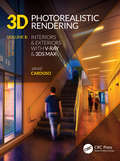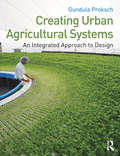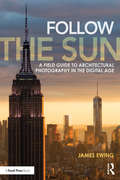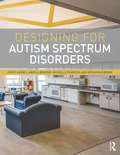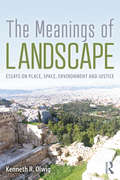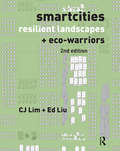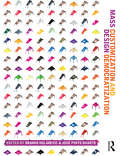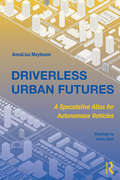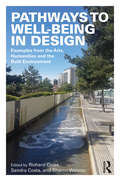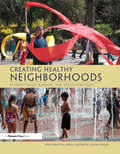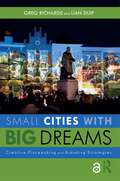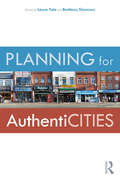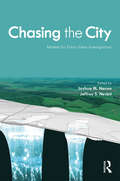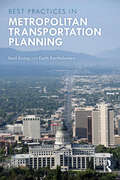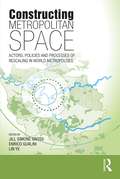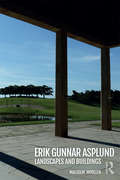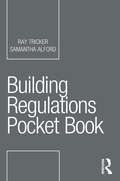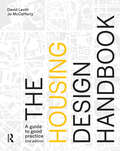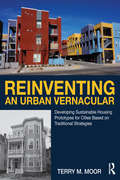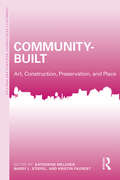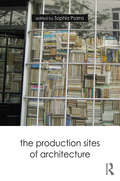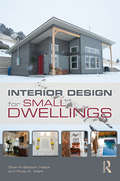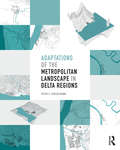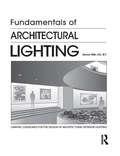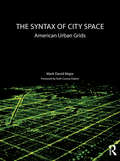- Table View
- List View
3D Photorealistic Rendering: Interiors & Exteriors with V-Ray and 3ds Max (3D Photorealistic Rendering)
by Jamie CardosoIncrease the photorealism of your 3d visualizations with enhanced toolsets of V-ray in 3ds Max. Full-color, step-by-step tutorials about techniques involved in creating photorealistic renders for interior/exterior scenes. Each tutorial includes a 3d project scene to guide you through, production and post-production. The production chapter shows how to create shaders, fine-tune textures and set up a day/night lighting rig. You will be rendering high-res images with render elements included for the final stage of post-production. The book also includes tips about, pre-production, camera settings, verified views, material editors, shaders, 3ds max scripts, and much more! Key Features This book deals with real world scenes and delivers up to date design direction. This book has professional supporting files ready for the reader to open and explore. This book highlights the processes of making your own content that not only gives images your personal touch, but also through the online content that will be made available for this title. Includes some coverage of VRay. Focuses in depth on separate issues surrounding interior, exterior and product design, which vary wildly.
Creating Urban Agricultural Systems: An Integrated Approach to Design
by Gundula ProkschCreating Urban Agriculture Systems provides you with background, expertise, and inspiration for designing with urban agriculture. It shows you how to grow food in buildings and cities, operate growing systems, and integrate them with natural cycles and existing infrastructures. It teaches you the essential environmental inputs and operational strategies of urban farms, and inspires community and design tools for innovative operations and sustainable urban environments that produce fresh, local food. Over 70 projects and 16 in-depth case studies of productive, integrated systems, located in North America, Europe, and Asia ,are organized by their emphasis on nutrient, water, and energy management, farm operation, community integration and design approaches so that you can see innovative strategies in action. Interviews with leading architecture firms, including WORKac, Kiss + Cathcart, Weber Thompson, CJ Lim/Studio 8, and SOA Architectes, highlight the challenges and rewards you face when creating urban agriculture systems. Catalogs of growing and building systems, a glossary, bibliography, and abstracts will help you find information fast.
Follow the Sun: A Field Guide to Architectural Photography in the Digital Age
by James EwingFollow the Sun will guide you through all aspects of architectural photography, from the genre’s rich history to the exciting new approaches brought by the advent of the digital age. It explains how to use the powerful tools of digital photography while employing many of the skills and traditions of the established genre. Written to be accessible to professionals, amateurs, and students alike, this book will be useful for photographers exploring architecture as fine artists, on editorial assignments, or on commercial shoots. Key features include: • Example photographs and diagrams • Historical background of architectural photography • Advice on essential equipment • How to plan a shoot to your advantage • How to use tilt-shift lenses for architecture • Editing workflow and strategies • Interviews with architectural photographers Peter Aaron, Magda Biernat, Ty Cole, and Elizabeth Felicella.
Designing for Autism Spectrum Disorders
by Angela Bourne Michelle Pearson Kristi Gaines Mesha KleibrinkWinner of the 2017 IDEC Book Award, 2017 EDRA Great Places Award (Book Category), 2017 American Society of Interior Designers Joel Polsky Prize and the 2016 International Interior Design Association TXOK Research Award Designing for Autism Spectrum Disorders explains the influence of the natural and man-made environment on individuals with autism spectrum disorders (ASD) and other forms of intellectual/developmental disabilities (IDD). Drawing on the latest research in the fields of environmental psychology and education, the authors show you how architecture and interior spaces can positively influence individuals with neurodiversities by modifying factors such as color, lighting, space organization, textures, acoustics, and ventilation. Now you can design homes, therapeutic environments, work environments, and outdoor spaces to encourage growth and learning for the projected 500,000 children with ASD (in the United States alone) who are expected to reach adulthood by 2024. Topics discussed include:-Environmental design theories-Symptoms of ASD-Sensory processing deficits -Design needs of individuals on the spectrum at all ages-Design methods and solutions for spaces, including residential, learning, work, and therapeutic environments encompassing a wide range of budgets-Designing for self-actualization, well-being, and a high quality of life for the duration of an individual's life-Avenues for healthy living and aging in place-Biophilic design-Environmental impact on well-being -Strategies to promote active living as an integral part of the welfare focus.
The Meanings of Landscape: Essays on Place, Space, Environment and Justice
by Kenneth R. OlwigCompiling eighteen authoritative essays spanning an extensive academic career, author Kenneth R. Olwig presents explorations in landscape geography and architecture from an environmental humanities perspective. With influences from art, literature, theatre staging, architecture, and garden design, landscape has come to be viewed as a form of spatial scenery, but this reading captures only a narrow representation of landscape meaning today. This book positions landscape as a concept shaped through the centuries, evolving from place to place to provide nuanced interpretations of landscape meaning. The essays are woven together to gather an international approach to understanding the past and present importance of landscape as place and polity, as designed space, as nature, and as an influential factor in the shaping of ideas in a just social and physical environment. Aimed at students, scholars, and researchers in landscape and beyond, this illustrated volume traces the idea of landscape from the ancient polis and theatre through to the present day.
Smartcities, Resilient Landscapes and Eco-Warriors: The Ecological Landscapes For Urban Resilience
by CJ Lim Ed LiuFollowing on from the success of the first edition, Smartcities + Eco-Warriors (2010), this book is the latest innovative response on urban resilience from one of the world’s leading urban design and architectural thinkers. An ecological symbiosis between nature, society and the built form, the Smartcity cultivates new spatial practices and creates diverse forms of resilient landscapes including and beyond urban agriculture. The notion of the Smartcity is developed through a series of international case studies, some commissioned by government organisations, others speculative and polemic. This second edition has nine new case studies, and additional ecological sustainability studies covering sensitivity, design criteria, and assessments for ecological construction plans. The book concludes with two new essays on the romance of trees and the empowering nature of resilient landscapes. Smartcities, Resilient Landscapes + Eco-warriors represents a crucial voice in the discourse of climate change and the potential opportunities to improve the ecological function of existing habitats or create new landscapes which are considered beneficial to local ecology and resilience. It is indispensable reading for practitioners and students in the fields of landscape, urban design, architecture and environmental engineering. An inspiration to government agencies and NGOs dealing with sustainability, this work also resonates with anyone concerned about cities, landscapes, food and water security, and energy conservation.
Mass Customization and Design Democratization
by Branko Kolarevic José Pinto DuarteParametric design and digital fabrication are enabling non-designers to mass produce non-standard, highly differentiated products – from shoes and tableware to furniture and even houses. The result of these newly available mass customization tools has been a ‘democratization’ of design. Mass Customization and Design Democratization is the first book to address this recent phenomenon. Demonstrating how the considerable potential of these tools can be realized in practice, it introduces essential technologies and design approaches and provides numerous examples of the latest, cutting edge work from leading design firms, manufacturers and thinkers. The book examines what mass customization means for architecture and the building industry and investigates its impact on the sector’s most commoditized enterprise – suburban housing. Asking whether design democratization is viable in the current context and exploring what kind of mass customization is possible, useful, and desirable, it poses fundamental questions about the authorship of design and the functional and aesthetic quality of products designed by non-designers. A highly designed book featuring over 200 color illustrations, this is essential reading for professionals as well as students taking courses in digital architecture, parametric design, and mass customization.
Driverless Urban Futures: A Speculative Atlas for Autonomous Vehicles
by AnnaLisa MeyboomSince the industrial revolution, innovations in transportation technology have continued to re-shape the spatial organization and temporal occupation of the built environment. Today, autonomous vehicles (AVs, also referred to as self-driving cars) represent the next disruptive innovation in mobility, with particularly profound impacts for cities. At a moment of the fast-paced development of AVs by auto-making companies around the world, policymakers, planners, and designers need to anticipate and address the many questions concerning the impacts of this new technology on urbanism and society at large. Conceived as a speculative atlas –a roadmap to unknown territories– this book presents a series of drawings and text that unpack the potential impacts of AVs on scales ranging from the metropolis to the street. The work is both grounded in a study of the history of urban transportation and current trajectories of technological innovation, and informed by an open-ended attitude of future envisioning and design. Through the drawings and essays, Driverless Urban Futures invites readers into a debate of how our future infrastructure could benefit all members of the public and levels of society.
Pathways to Well-Being in Design: Examples from the Arts, Humanities and the Built Environment
by Richard Coles Sandra Costa Sharon WatsonHow can we achieve and promote well-being? Drawing on examples from the arts, humanities and design, this book brings together work from a wide range of areas to reveal the unique ways in which different disciplines approach the universal goal of supporting well-being. Pathways to Well-Being in Design recognises that the distinction between academics and practitioners often becomes blurred, where, when working together, a fusion of thoughts and ideas takes place and provides a powerful platform for dialogue. Providing new insights into the approaches and issues associated with promoting well-being, the book's multi-disciplinary coverage invites readers to consider these ideas within the framework of their own work. The book's 12 chapters are authored by academics who are involved in practice or are working with practitioners and features real world case studies which cover a range of situations, circumstances, environments, and social groups. Pathways to Well-Being in Design responds to those wishing to enquire further about well-being, taking the reader through different circumstances to consider approaches, discussing practice and theory, real world and virtual world considerations. This book is essential reading for anyone seeking to understand well-being, including students and professionals in architecture, landscape architecture, urban planning, design and health sciences.
Creating Healthy Neighborhoods: Evidence-Based Planning and Design Strategies
by Ann Forsyth Emily Salomon Laura SmeadGood housing. Easy transit. Food access. Green spaces. Gathering places. Everybody wants to live in a healthy neighborhood. Bridging the gap between research and practice, it maps out ways for cities and towns to help their residents thrive in placed designed for living well, approaching health from every side – physical mental, and social.
Small Cities with Big Dreams: Creative Placemaking and Branding Strategies
by Greg Richards Lian DuifHow can small cities make an impact in a globalizing world dominated by ‘world cities’ and urban development strategies aimed at increasing agglomeration? This book addresses the challenges of smaller cities trying to put themselves on the map, attract resources and initiate development. Placemaking has become an important tool for driving urban development that is sensitive to the needs of communities. This volume examines the development of creative placemaking practices that can help to link small cities to external networks, stimulate collaboration and help them make the most of the opportunities presented by the knowledge economy. The authors argue that the adoption of more strategic, holistic placemaking strategies that engage all stakeholders can be a successful alternative to copying bigger places. Drawing on a range of examples from around the world, they analyse small city development strategies and identify key success factors. This book focuses on the case of ‘s-Hertogenbosch, a small Dutch city that used cultural programming to link itself to global networks and stimulate economic, cultural, social and creative development. It advocates the use of cultural programming strategies as a more flexible alternative to traditional top-down planning approaches and as a means of avoiding copying the big city. The Open Access version of this book, available at http://www.taylorfrancis.com, has been made available under a Creative Commons Attribution-Non Commercial-No Derivatives (CC-BY-NC-ND) 4.0 license.
Planning for AuthentiCITIES
by Laura Tate Brettany ShannonAuthenticity resonates throughout the urbanizing world. As cities’ commercial corridors and downtowns start to look increasingly the same, and gentrification displaces many original neighborhood residents, we are left with a sense that our cities are becoming "hollowed out," bereft of the multi-faceted connections that once rooted us to our communities. And yet, in a world where change is unrelenting, people long for authentic places. This book examines the reasons for and responses to this longing, considering the role of community development in addressing community and neighbourhood authenticity. A key concept underscoring planning’s inherent challenges is the notion of authentic community, ranging from more holistic, and yet highly market-sensitive conceptions of authentic community to appreciating how authenticity helps form and reinforce individual identity. Typically, developers emphasize spaces’ monetary exchange value, while residents emphasize neighbourhoods’ use value—including how those spaces enrich local community tradition and life. Where exchange value predominates, authenticity is increasingly implicated in gentrification, taking us further from what initially made communities authentic. The hunger for authenticity grows, in spite and because of its ambiguities. This edited collection seeks to explore such dynamics, asking alternately, "How does the definition of ‘authenticity’ shift in different social, political, and economic contexts?" And, "Can planning promote authenticity? If so, how and under what conditions?" It includes healthy scepticism regarding the concept, along with proposals for promoting its democratic, inclusive expression in neighbourhoods and communities.
Chasing the City: Models for Extra-Urban Investigations
by Joshua M Nason Jeffrey S NesbitHistorically, many architects, planners, and urban designers solicit idealistic depictions of a controllable urban environment made from highly regulated geometrical organizations and systematically defined processes. Rather than working as urban "designers" who set out to control and implant external processes, we shift our approach to that of urban "detectives," who set out to chase the city. Charged with approaching the city more responsively, we investigate what we do not know, allowing the city to direct our work. As urban detectives, we have the ability to interrogate and respond to the elaborate patterns emerging from self-generated, internalized urban interactions. Chasing the City asks what are the current design trends shaping how we, first, understand the cities of today to, then, produce informed decisions on the continuously undefined evolving city of tomorrow. Intentionally, the work here does not adhere to rudimentary notions of supposed singularities or rely upon past generations of idealistic utopian models. Rather, Chasing the City delineates current models of urban investigation that seek to respond to the nature of cities and develop heretofore-urban strategies as concurrently negotiated future urbanism. This edited volume provides a collection of innovative design research projects based on shared notions of Chasing the City through three bodies of strategic frameworks: (1) Mapping, (2) Resource, and (3) Typology. This structure ultimately allows readers, as fellow urban detectives, access to exploratory tools and methods of detection that accumulate from our environs, both practical and projective in our chase of the city.
Best Practices in Metropolitan Transportation Planning: New Advances, Approaches, And Best Practices
by Reid Ewing Keith BartholomewPlanning at a metropolitan scale is important for effective management of urban growth, transportation systems, air quality, and watershed and green-spaces. It is fundamental to efforts to promote social justice and equity. Best Practices in Metropolitan Transportation Planning shows how the most innovative metropolitan planning organizations (MPOs) in the United States are addressing these issues using their mandates to improve transportation networks while pursuing emerging sustainability goals at the same time. As both a policy analysis and a practical how-to guide, this book presents cutting-edge original research on the role accessibility plays - and should play - in transportation planning, tracks how existing plans have sought to balance competing priorities using scenario planning and other strategies, assesses the results of various efforts to reduce automobile dependence in cities, and explains how to make planning documents more powerful and effective. In highlighting the most innovative practices implemented by MPOs, regional planning councils, city and county planning departments and state departments of transportation, this book aims to influence other planning organizations, as well as influence federal and state policy discussions and legislation.
Constructing Metropolitan Space: Actors, Policies and Processes of Rescaling in World Metropolises
by Jill Simone Gross Enrico Gualini Lin YeThere is little question today that processes of globalization affect national and local economies, governance processes, and conditions for economic competitiveness in the major urban regions of the world. In most liberal-democratic countries, these processes are occurring according to a rationale which attempts to combine strategies of state-supported development with increasing local-regional governmental decentralization and autonomy. Against this background, the issue of metropolitan development is being redefined worldwide, along with its institutional frameworks, modes of governance, policy instruments, and spatial planning strategies. The overarching assumption of this volume is that ‘metropolitan space’, far from being consolidated as a policy object, is currently being redefined and in some instances ‘constructed’ and contested as a scale, through a variety of policy practices related to spatial-economic development objectives. Through case studies drawn from across four continents, the authors reveal a range of interesting cross-national commonalities concerning the power that state actors, situated at various spatial scales, exert as agents in these processes. This volume interrogates key research issues raised by these developments, and is intended as a contribution to the establishment of a globally comparative analysis of the construction of metropolitan spaces and scales under conditions of globalization and neoliberalization.
Erik Gunnar Asplund: Landscapes and Buildings
by Malcolm WoollenTaking an interdisciplinary approach, weaving together art, philosophy, history, and literature, this book investigates the landscapes and buildings of Swedish architect Erik Gunnar Asplund. Through critical essays and beautiful illustrations focusing on four projects, the Woodland Cemetery, the Stockholm Public Library, the Stockholm Exhibition and Asplund’s own house at Stennäs, it addresses the topic of buildings accompanied by landscapes. It proposes that themes related to landscape are central to Asplund’s distinctive work, with these particular sites forming a collection that documents an evolution in his design thinking from 1915 to 1940. The architect himself wrote comparatively little about his design intentions. However, through close reading and analysis of the selected projects as landscapes with architecture, author Malcolm Woollen argues that reflections of the history of Swedish landscape architecture and the intellectual climate in the late nineteenth and early twentieth centuries are evident in his work and help to explain the architect’s intentions. This book is a must-have for academics, advanced students and researchers in landscape architecture and design who are interested in Nordic Classicism and the works of Erik Gunnar Asplund.
Building Regulations Pocket Book (Routledge Pocket Books)
by Ray Tricker Samantha AlfordThis handy guide provides you with all the information you need to comply with the UK Building Regulations and Approved Documents. On site, in the van, in the office, wherever you are, this is the book you’ll refer to time and time again to double check the regulations on your current job. The Building Regulations Pocket Book is the must have reliable and portable guide to compliance with the Building Regulations. Part 1 provides an overview of the Building Act Part 2 offers a handy guide to the dos and don’ts of gaining the Local Council’s approval for Planning Permission and Building Regulations Approval Part 3 presents an overview of the requirements of the Approved Documents associated with the Building Regulations Part 4 is an easy to read explanation of the essential requirements of the Building Regulations that any architect, builder or DIYer needs to know to keep their work safe and compliant on both domestic or non-domestic jobs This book is essential reading for all building contractors and sub-contractors, site engineers, building engineers, building control officers, building surveyors, architects, construction site managers and DIYers. Homeowners will also find it useful to understand what they are responsible for when they have work done on their home (ignorance of the regulations is no defence when it comes to compliance!).
The Housing Design Handbook: A Guide to Good Practice
by David Levitt Jo McCaffertyEveryone deserves a decent and affordable home, a truth (almost) universally acknowledged. But housing in the UK has been in a state of crisis for decades, with too few homes built, too often of dubious quality, and costing too much to buy, rent or inhabit. It doesn’t have to be like this. Bringing together a wealth of experience from a wide range of housing experts, this completely revised edition of The Housing Design Handbook provides an authoritative, comprehensive and systematic guide to best practice in what is perhaps the most contentious and complex field of architectural design. This book sets out design principles for all the essential components of successful housing design – including placemaking, typologies and density, internal and external space, privacy, security, tenure, and community engagement – illustrated with case studies of schemes by architecture practices working across the UK and continental Europe. Written by David Levitt and Jo McCafferty – two recognised authorities in the field – and with contributions from more than twenty other leading practitioners, The Housing Design Handbook is an essential reference for professionals and students in architecture and design as well as for government bodies, housing associations and other agencies involved in housing.
Reinventing an Urban Vernacular: Developing Sustainable Housing Prototypes for Cities Based on Traditional Strategies
by Terry MoorWith increasing population and its associated demand on our limited resources, we need to rethink our current strategies for construction of multifamily buildings in urban areas. Reinventing an Urban Vernacular addresses these new demands for smaller and more efficient housing units adapted to local climate. In order to find solutions and to promote better urban communities with an overall environmentally responsible lifestyle, this book examines a wide variety of vernacular building precedents, as they relate to the unique characteristics and demands of six distinctly different regions of the United States. Terry Moor addresses the unique landscape, climate, physical, and social development by analyzing vernacular precedents, and proposing new suggestions for modern needs and expectations. Written for students and architects, planners, and urban designers, Reinventing an Urban Vernacular marries the urban vernacular with ongoing sustainability efforts to produce a unique solution to the housing needs of the changing urban environment.
Community-Built: Art, Construction, Preservation, and Place (Community Development Research and Practice Series)
by Katherine Melcher Barry Stiefel Kristin FaurestThroughout history and around the world, community members have come together to build places, be it settlers constructing log cabins in nineteenth-century Canada, an artist group creating a waterfront gathering place along the Danube in Budapest, or residents helping revive small-town main streets in the United States. What all these projects have in common is that they involve local volunteers in the construction of public and community places; they are community-built. Although much attention has been given to specific community-built movements such as public murals and community gardens, little has been given to defining community-built as a whole. This volume provides a preliminary description of community-built practices with examples from the disciplines of urban design, historic preservation, and community art. Taken as a whole, these community-built projects illustrate how the process of local involvement in adapting, building, and preserving a built environment can strengthen communities and create places that are intimately tied to local needs, culture, and community. The lessons learned from this volume can provide community planners, grassroots facilitators, and participants with an understanding of what can lead to successful community-built art, construction, preservation, and placemaking.
The Production Sites of Architecture
by Sophia PsarraThe Production Sites of Architecture examines the intimate link between material sites and meaning. It explores questions such as: how do spatial configurations produce meaning? What are alternative modes of knowledge production? How do these change our understanding of architectural knowledge? Featuring essays from an international range of scholars, the book accepts that everything about the production of architecture has social significance. It focuses on two areas: firstly, relationships of spatial configuration, form, order and classification; secondly, the interaction of architecture and these notions with other areas of knowledge, such as literature, inscriptions, interpretations, and theories of classification, ordering and invention. Moving beyond perspectives which divide architecture into either an aesthetic or practical art, the authors show how buildings are informed by intersections between site and content, space and idea, thought and materiality, architecture and imagination. Presenting illustrated case studies of works by architects and artists including Amale Andraos, Dan Wood, OMA, Koen Deprez and John Soane, The Production Sites of Architecture makes a major contribution to our understanding of architectural theory.
Interior Design for Small Dwellings
by Sherrill Baldwin Halbe Rose K MarkInterior Design for Small Dwellings addresses the onrush of interest in smaller homes and the possibility that small dwellings might be the answer to housing needs and sustainability. The book explores key principles essential to residing and designing small interiors with emphasis on client involvement and implementation of participatory, inclusive design as advocated by the Council for Interior Design Accreditation. Does living in a small space mean living small? The authors believe that by simplifying one’s life intelligently and applying certain principles of design, planning and organization, one can actually live a meaningful life in a smaller space. These tenets are based on the authors’ professional experiences and living in small homes. To this end, the book provides discussion, images, case studies, interviews, worksheets, activities and suggested explorations. Interior Design for Small Dwellings is a teaching guide and provides information and exercises that help professional designers utilize design theory, space planning and programming techniques. Throughout, the text affords sustainability, biophilic design and wellness methodologies.
Adaptations of the Metropolitan Landscape in Delta Regions
by Peter C BosselmannAdaptations of the Metropolitan Landscape in Delta Regions is about environmental quality and the long term livability of urban areas. In decades to come, climate change will affect cities everywhere, but nowhere have the effects of climate change already been felt as strongly as in low-lying coastal cities, cities located in large river deltas and near tidal estuaries. This book reflects on the contribution that spatial planning and urban design can make to a complex discussion about how city form and landscapes will need to adapt within metropolitan areas. The book’s focus is on the urban form of three delta regions: the Pearl River Delta in Southern China; the Rhine, Maas, and Scheldt Delta in the Netherlands; and the San Francisco Bay Area in Northern California. The three regions differ greatly, but despite their different political systems, history, culture and locations in three different climate zones, all three regions will be forced to respond to similar issues that will trigger transformations and adaptations to their urban form. Richly illustrated in color with detailed diagrams, models, photographs and sketches, the book is written for students, scholars and practitioners of environmental planning, and designers who need to respond to the future form of cities in light of climate change. For the professions shaping the physical world of cities and regions, the challenge is not only one of designing physical geometries but of social consequences.
Fundamentals of Architectural Lighting
by Samuel MillsThe theme of this book is that light is an inseparable part of architectural design, and is intended to provide students of architecture and interior design with a graphic guideline to the fundamental role lighting plays in this process. While simple light sources may be enough to satisfy practical needs, the design process must expand beyond basic illumination. The challenge for architects and designers is the creation of luminous environments offering visual interest and a sense of well-being, while also meeting basic seeing needs. Technological advances provide opportunities for the lighting designer's creative introduction of light, and the visual and psychological perceptions of the illuminated architectural environment. Fundamentals of Architectural Lighting offers a complete comprehensive guide to the basics of lighting design, equipping students and practitioners with the tools and ideas they need to master a variety of lighting techniques. The book is extensively illustrated with over 250 illustrations to demonstrate basic principles and procedures. It is an excellent resource for anyone interested in the fundamentals of integrated lighting for architectural interior spaces.
The Syntax of City Space: American Urban Grids
by Mark David MajorMany people see American cities as a radical departure in the history of town planning because of their planned nature based on the geometrical division of the land. However, other cities of the world also began as planned towns with geometric layouts so American cities are not unique. Why did the regular grid come to so pervasively characterize American urbanism? Are American cities really so different? The Syntax of City Space: American Urban Grids by Mark David Major with Foreword by Ruth Conroy Dalton (co-editor of Take One Building) answers these questions and much more by exploring the urban morphology of American cities. It argues American cities do represent a radical departure in the history of town planning while, simultaneously, still being subject to the same processes linking the street network and function found in other types of cities around the world. A historical preference for regularity in town planning had a profound influence on American urbanism, which endures to this day.
